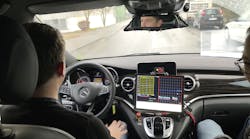High-end cars are some of the most complex machines in the world, with miles of wires linking more than a hundred electronic control units powering everything from windshield wipers to digital speedometers. This is all programmed with millions more lines of code than a fighter jet.
But automotive engineers are plotting to change how all these parts are connected so that cars can handle the bandwidth and wiring necessary for infotainment and autonomous driving as well as existing functions. They plan to install computer systems that take over the tasks of multiple control units simultaneously, share the same radar and other sensors, and talk to each other in almost real-time.
That will require changes to how wires are crammed behind door panels and dashboards. To make these changes possible, automotive engineers may start using products from Valens Semiconductor, a fabless chipmaker based in Hod Hasharon, Israel.
Valens started out over a decade ago selling networking chips for professional audio and visual devices. But now it is trying to use the same technology to recreate the car’s connective tissue. Its chips encode data so that they can traverse the car’s network over a single unshielded twisted pair cable, replacing many others to reduce cost and weight.
“The car is becoming like an advanced data center,” said Micha Risling, vice president of Valens’ automotive business, only two years old but already selling a series of chipsets. The comparison works because the cameras, radar, and other sensors in a fully driverless vehicle could discharge more than four terabytes of data every hour and a half of driving.
To handle it all, Valens is betting on HDBaseT, a standard it invented to transmit uncompressed audio and video, control, Ethernet, USB, and a hundred watts of power simultaneously. It can do this over a single copper cable, which does not have the thick, expensive insulation of traditional cables. That way, it can be tucked into tight spaces in cars.
Along with Samsung and Sony, the chipmaker turned HDBaseT into a standard in 2010. The technology, a rival to HDMI, found a sweet spot in sending high-definition video around factory floors and corporate offices over a copper cable up to 328 feet. The HDBaseT Alliance, an industry group with 190 members, develops the standard.
But last year, Daimler said that it would use HDBaseT to connect its infotainment, telematics, and advanced driver assistance systems. Valens’ chief executive, Dror Jerushalmi, said that Daimler would start using it in production cars by 2020. GM, which sits on the alliance’s board, declined to comment on whether it planned to use HDBaseT.
Valens could have other major customers in the next few years. In April, the company raised $60 million from investors including Delphi and Samsung, which owns infotainment supplier Harman. With the money, Valens can expand its product line to compete with bigger rivals like Marvell and Broadcom, which makes networking chips for Ethernet that – like HDBaseT – work with a single unshielded copper cable.
“The automotive industry will not have a choice but to move to a centralized approach, simply given that so much processing power is needed. And again, the raw data will have to be processed differently to be used in different clusters,” said Risling in a recent interview. “The sensors really should be as dumb as possible.”
And advanced sensors that can process data themselves cost significantly more than simpler devices, Risling explained. “There is also the question of what happens if you process raw radar inside complex sensors and the car gets into an accident. The chances are high that these sensors will be damaged,” he told Electronic Design.
Valens' chips can be used to convey uncompressed video from a rear-view camera, for example, to both the dashboard display where the driver can watch for other cars and the collision avoidance system, which also monitors the car's surroundings. The stream can be transmitted to both systems simultaneously at multiple gigabits per second.
Risling claims that automakers can more than recoup the cost of Valens’ chips, which are more expensive than previous solutions for car networking. “Valens devices can tunnel several native streams over a single channel simultaneously while other technologies require multiple chipsets, connectors and cables,” he said.
“Moreover, HDBaseT is not limited to point-to-point topologies and can also support daisy-chaining as well as multi-hop switching and [in that way] reduces the connectivity bottlenecks towards the main ECUs,” he said. “Our ability to support multi-streams over a single channel opens the door for advanced cost-effective interfacing options with other chips in the system.”
Valens can also deal with electromagnetic interference that leaks out of cables and can cripple performance. The company’s chips can monitor and cancel noise. It also shorted the range of HDBaseT to 50 feet so that cables could transmit at lower frequencies, which can better resist interference. That means they do not need the heavy rubber shielding of traditional cables.
The company can sacrifice range because, even though new vehicles are packed with miles of cabling, no system needs to send data 328 feet.
Risling said Valens is trying to make connectivity easier for automakers racing to build autonomous cars powered by computers from companies like Nvidia and Intel. Its chips have ways to compensate for aging cables and temperature changes, and the company is also working on cybersecurity that can be designed into a car’s electronic architecture.
“You have this freedom to innovate and go crazy, while we provide the infrastructure,” Risling said.

